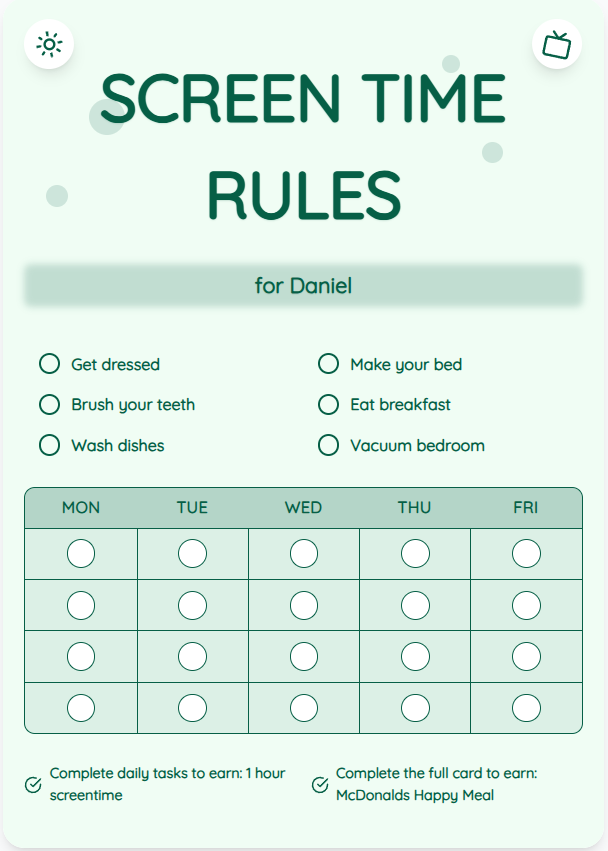Exploring the Health Impact of Screen Time on Children
As a parent, you may wonder whether screen time is healthy for your child. In this guide, we delve into the effects of excessive screen time on children's well-being and provide actionable advice to create a balanced approach.
See What Your Screen Time Chart Will Look Like
Here's an example of a beautiful, customizable screen time rules chart you can create for your family

Understanding Screen Time and Its Impact
Screen time refers to the amount of time children spend using digital devices such as smartphones, tablets, computers, and TVs. While technology offers numerous benefits, excessive screen time can have negative effects on children's physical health, mental well-being, and social development. Studies have linked extended screen time to issues like obesity, sleep disturbances, behavioral problems, and reduced academic performance.
Setting Healthy Screen Time Limits
Establishing clear screen time limits is crucial for promoting a healthy balance. Create a screen time chart that outlines specific daily limits for different activities and age groups. Encourage a variety of activities beyond screens, such as outdoor play, reading, and creative pursuits. Consistency and parental involvement are key to enforcing these limits effectively.
Put These Tips Into Action
Create a custom chart to implement these strategies with your child
Promoting Positive Screen Time Habits
Focus on quality over quantity when it comes to screen time. Choose educational and age-appropriate content for your child to engage with. Co-viewing or co-playing with your child can enhance the learning experience and foster meaningful interactions. Encourage breaks during screen time sessions to reduce eye strain and promote physical activity.
Creating a Tech-Friendly Family Environment
Lead by example by modeling healthy screen habits for your children. Establish tech-free zones in the house, such as the dining table or bedrooms, to encourage face-to-face communication and relaxation. Engage in open conversations about responsible technology use and the importance of balance in daily routines.
Practical Tips for Success
- Limit screen time before bedtime to promote better sleep quality.
- Use screen time as a reward for completing homework or chores.
- Encourage outdoor play and physical activities to offset sedentary screen time.
- Utilize screen time charts to visually track and manage your child's device usage.
Frequently Asked Questions
How much screen time is recommended for children?
The American Academy of Pediatrics recommends limiting screen time to 1 hour per day for children aged 2-5 and promoting consistent limits for older children based on individual needs.
Can screen time charts help in managing device usage?
Yes, screen time charts provide a visual guide for setting daily limits and tracking your child's screen time activities. They help establish boundaries and encourage a healthier balance between screen time and other activities.
What are the signs of excessive screen time in children?
Signs of excessive screen time include irritability, difficulty concentrating, disrupted sleep patterns, and a lack of interest in non-screen activities. Monitoring your child's behavior can help identify potential issues related to screen time.
By understanding the impact of screen time on children's health and implementing practical strategies, you can create a balanced approach that promotes overall well-being. Consider utilizing screen time charts from ScreenTimeRules.com to manage and monitor your child's device usage effectively.
Ready to Transform Your Family's Screen Time?
Join thousands of parents who have successfully managed screen time with our customizable charts.
